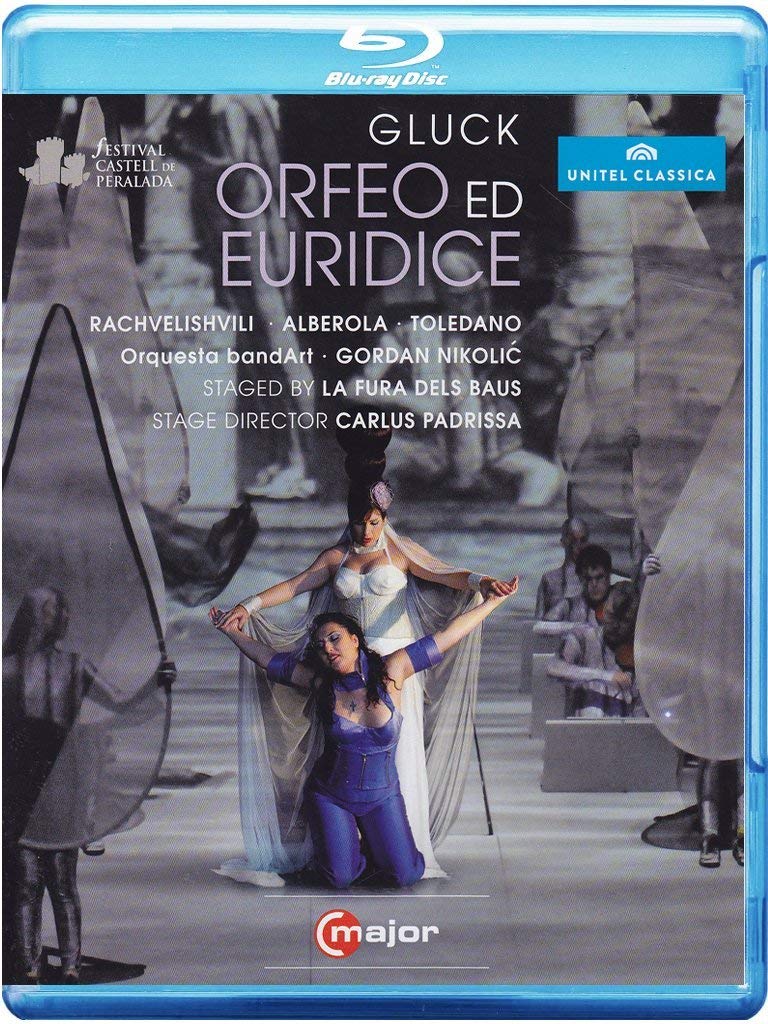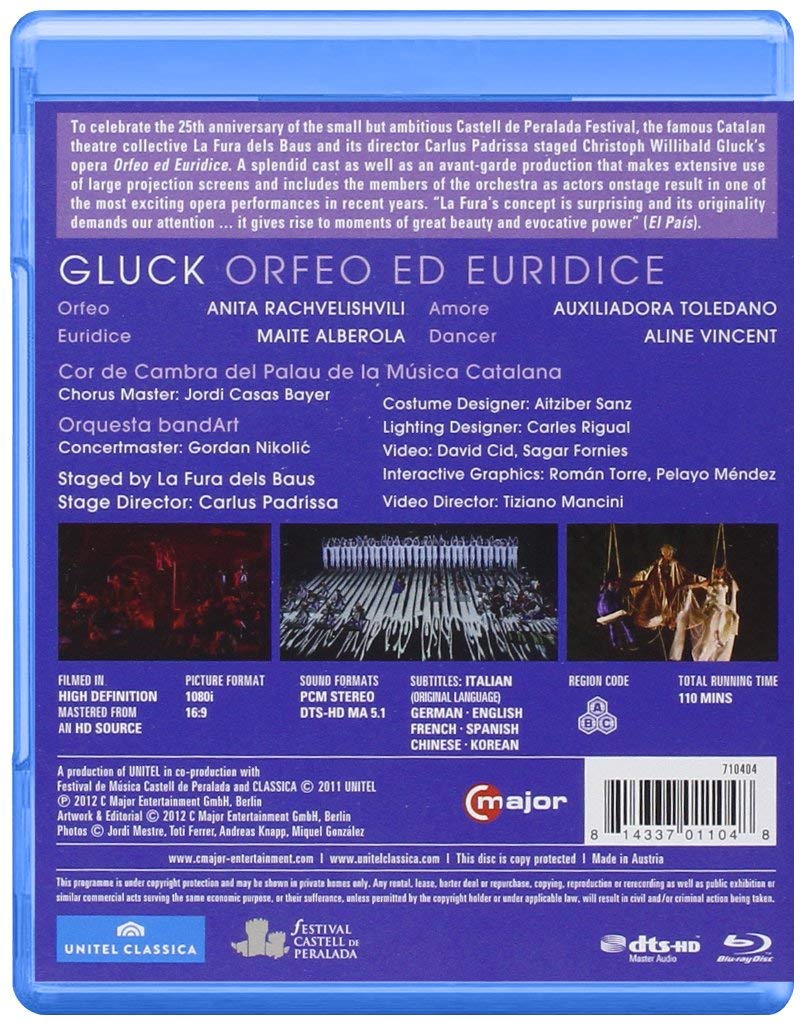

Gluck Orfeo ed Euridice opera to a libretto by Ranieri de' Calzabigi. Directed 2011 by Carlus Padrissa at the 25th Festival Castell de Peralada in Catalonia, Spain. Stars Anita Rachvelishvili (Orfeo), Maite Alberola (Euridice) , Auxiliadora Toledano (Amore), and Aline Vincent (dancer). Gordan Nikolić conducts (as Concert Master) the Orquesta bandArt and the Cor de Cambra del Palau de la Música Catalana (Chorus Master Jordi Casas Bayer). Staged by La Fura dels Baus; costume design by Aitziber Sanz; lighting design by Carles Rigual; video by David Cid and Sagar Fornies; interactive graphics by Román Torre and Pelayo Méndez. Directed for TV direction by Tiziano Mancini. Sung in Italian. Released 2012, disc has 5.1 dts-HD Master Audio sound. Grade: D
This title was recorded at the open air auditorium of the Peralada Festival in the summer of 2011. Although the recorded applause sounds shockingly unenthusiastic, it may have been fun to watch live with the star singers dangling around strung from cables like window-washers. But alas, this title is just another example of how hard it is to record one of these outdoor extravaganzas so it will look good in a home theater in high-definition TV.
Before I explain why you should not buy this (unless you have a good special reason), let me say a couple of nice things about the singers. Auxiliadora Toledano is glorious in the too-short role of Amore. I'm full of admiration for Anita Rachvelishvili as Orfeo---she held up well in view of the tortures she endures at the hands of director Padrissa. I liked Maite Alberola as Euridice, even with her insane wig. Finally, I'm grateful to the Cor de Cambra under Jordi Casas Bayer for several passages of choral work that reminded me how beautiful this Gluck opera really is.
Now let's consider some of the horrors we encounter in this version of a round-trip to the underworld. The worst atrocity is the abuse of Orquesta bandArt. Here's what Orquesta bandArt says about itself on the Ad Libitum Artis website:
“Sir Colin Davis is the president of the orchestra, while the burden of music leadership is on Gordan Nikolic, soloist and first violin of the London Symphony Orchestra. bandArt is an independent orchestra, made up with musicians coming from the best orchestras all around Europe. bandArt's main goal is to be a non-director orchestra, open to universal musical dialogue, that tries to transmit the orchestral repertoire with freshness and enthusiasm.”
Orquesta bandArt doubtless gives wonderful concerts when they play on a regular stage with plenty of light and the conductor clearly in sight. But for this production they were required to march onto and maneuver about a dimly-lit stage constructed with a 30 degree slope down from the rear of the stage to the front. Much of the time most of the players had "cockpits" cut into the stage in which to sit. But often they were required to move about the stage, acting sometimes as protagonists, while continuing to play. The harpsichord had a level place at the front edge of the stage. The cellos and double basses were forced to cope with the slope. (I never before this saw anyone playing a cello on the march, but it can be done.) Add to the treacherous dark terrain the musicians' weird lizard-skin costumes (with black face markings), the incessant flickering of the La Fura dels Baus light projections, the antics of chorus members with strange props, the singers on beams that rose out of the floor, and the aerial action---and you have an extremely distracting and even dangerous playing environment. Small wonder then that this performance by Orquesta bandArt is the worst I've ever heard from a recording being offered for sale by an established publisher. It's that bad, but it's not the fault of Orquesta bandArt. It's a miracle they fulfilled the contract, never fell apart on the stage, and nobody got killed.
Since there is no conductor, the role of the director Carlus Padrissa is magnified. Will Rodgers never met a man he didn't like. And Padrissa never learned of a special effect he didn't use. This may be justified in an open-air theater where the spectators can just keep drinking more wine if they are bored with the show. Management doesn't want them driving drunk, so they keep giving them something new to see. But in the home theater, the Fura dels Baus special effects fast lose their appeal due to of the repetitive feel of the computer-generated images and the fact that they too often interfere with rather than enhance the music and acting on the stage.
Below is a relatively mild La Fura dels Baus scene from the opening of the opera. The musicians in the background projection are some of the bandArt folks. The full orchestra is seated in special cockpits cut into the sloping stage. Orfeo (Rachvelishvili) is the figure in blue in the middle; the resolution is poor in the dim light. Chorus members in lizard outfits display teardrops of mourning. The scene is enhanced (I say degraded) with rapid flickering of partial shadows across the stage:
The bandArt folks play the role of Furies while trying to play Gluck. Orfeo (Rachvelishvili) is perched for a long time on the top of a tall beam protected a safety harness and cable. This gear isn't noticeably here but it is distracting in mid-range and close shots:
Orfeo and Euridice. Orfeo is dressed in a jumpsuit. So would all that gear on top be for a parachute? No, it's the safety harness. Euridice is still in her wedding dress. But that's not a corset she's wearing over it. It's her safety harness, and she will also be airborne before this is over. Translation: "No, death is dearer to me...":
Orpheus charms the shades guarding the entrance to the underworld and gains safe passage. Behind is the railroad gate to Birkenau at Auschwitz. Few survived that gate. Is this an appropriate use of this Holocaust image, or is this another example of excess in the use of special effects?
The Dance of the Blessed Spirits. This is so weak when compared to, say, the Frieden (Peace) Act in the Pina Bausch Orpheus und Eurydike dance-opera that we have in HDVD.
Now we get the piling on of double images in post production on top of the real-time special effects. There are quite a few such overdone scenes in the published recording:”
Another error of judgment by Padrissa was to fail to make it clear that Orpheus is a male character. Are you trying to sell young audiences on opera? Well, could youngsters seeing this get confused and think that Gluck wrote a tragedy about Lesbian love? Opera fans know, of course, about the castrati and the later "trouser roles." Casting Rachvelishvili for this was legitimate in view of the history of this opera. I admit that Rachvelishvili is wearing trousers here. But the rest of the package isn't right: how do you make husband and wife out of this?
Finally, the picture quality of this production is poor. There are a few sharp images in closeup when the light level was reasonably high. But most of this title is plagued with grain and low resolution due to the low-light level. This is often a problem with outside productions where the owners of the venue have not made the investment required to have light levels similar to those of dedicated indoor opera houses.
Here the final, famous aria is ruined by an obvious scrim in a gross field-of-focus error. Translation: "Where will I go without my love?"
Several magazine critics see this differently than I. David Patrick Sterns in the November 2012 Gramophone (page 82) likes the singers enough to pass on all the issues I raised. Mark Mandel in the February 2013 issue of Opera News goes so far as to say that the dancing and conductor-less members of Orquesta bandArt show "no loss of precision or intensity in their playing." One way I can understand that statement is to assume that bandArt always plays horribly. But Orquesta bandArt is highly respected, so something may be wrong with my analysis. Maybe this is a more helpful statement: I think the standards for a good opera video recording are today and will be in the future much higher than they were in the past.
In summary, some good singing saves this from the F-bomb. But overall this title is so weak — it probably should not have been released. There's plenty of room for new HDVD recordings of Orfeo ed Euridice in straight opera form with either men or women properly directed as Orfeo. But for now, if you are interested in this work, you would be much better off with other HDVD choices we have. So I wind up with a D grade.
Final extra comment: after I did this review, we stopped covering outdoor concerts unless they had special merit. But I keep this review up as an example of the kind of debacle we are trying to avoid.
OR








